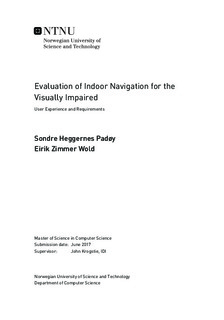Evaluation of Indoor Navigation for the Visually Impaired - User Experience and Requirements
Master thesis
Permanent lenke
http://hdl.handle.net/11250/2456354Utgivelsesdato
2017Metadata
Vis full innførselSamlinger
Sammendrag
There are many challenges regarding indoor navigation in unknown areas, and the difficulty is higher for the visually impaired. One significant question is the amount of information needed for visually impaired to independently and successfully navigate through complex buildings. In this study, a prototype application initially developed by MazeMap was further developed and maintained. This application was then used to test the amount of information needed and how this information should be presented to the user, and in what detail. An experiment, a survey and interviews were conducted with three participants. The experiment consisted of having the participants testing the prototype application while navigating through a building at Gløshaugen, a campus at the Norwegian University of Science and Technology (NTNU). In the survey and during the interviews, they provided feedback on the application and answered questions regarding their challenges for indoor navigation. The application was evaluated using the Technology Acceptance Model (TAM), focusing on Perceived Usefulness and Perceived Ease of Use.
Based on the TAM evaluation, this thesis concluded that the most important issue that need to be addressed is allowing the user to verify that the instructions are followed correctly. This can be executed by making use of electronic compass and precise indoor positioning systems in the application. Another possibility is using objects such as walls, doors, pillars or other structures as the endpoints in each instruction, since these are detectable with a white cane or guide dog. The research also stresses the importance of giving control to the users regarding the amount of information presented. This is important as different situations and users need different amounts of information.
